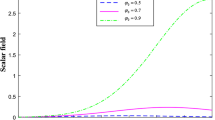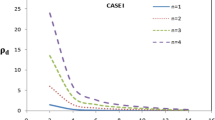Abstract
In this paper, we have studied spatially homogeneous anisotropic Bianchi type-I viscous fluid dark energy cosmological model interacting in the framework of scalar tensor theory (Saez–Ballester, Phys. Lett. A 113, 467 (1986)). The field equations are solved by applying a special variation law (power law) for the generalised Hubble parameter. It is observed that the present accelerated expansion of the Universe is affected by the distribution of dark energy. Some physical and geometrical features of the model have also been discussed.












Similar content being viewed by others
References
D Benisty and E I Guendelman, Phys. Rev. D 98, 023506 (2018)
D Tamayo and J A Vázquez, Mon. Not. R. Astron. Soc. 487, 729 (2019)
S Farnes, Astron. Astrophys. 620, A92 (2018)
B Saha, Int. J. Theor. Phys. 45, 983 (2006)
S Perlmutter et al, Astrophys. J. 517, 565 (1999)
M Cataneo et al, Mon. Not. R. Astron. Soc. 488, 2121 (2019)
A Costa et al, Mon. Not. R. Astron. Soc. 488, 78 (2019)
B Liu, Z Li and Z H Zhu, Mon. Not. R. Astron. Soc. 487, 1980 (2019)
S Mitra et al, Mon. Not. R. Astron. Soc. 487, 5118 (2019)
A A Aly, Pramana – J. Phys. 92, 34 (2019)
V C Dubey et al, Pramana – J. Phys. 93, 78 (2019)
C P Singh and A Kumar, Astrophys. Space Sci. 364, 94 (2019)
D Perkovic and H Stefancic, Phys. Lett. B 797, 134806 (2019)
A Pradhan, H Amirhashchi and B Saha, Int. J. Theor. Phys. 50, 2923 (2011)
G K Goswami et al, Mod. Phys. Lett. A 35, 2050086 (2020)
S D Katore et al, Hindawi Adv. High Energy Phys. 2018, 2854567 (2018)
R Bali, A Pradhan and A Rai, Prespacetime J. 5, 7 (2014)
K Nordtvedt Jr, Astrophys. J. 161, 1059 (1970)
D Saez and V J Ballester, Phys. Lett. A 113, 9, 467(1986)
A Y Shaikh et al, J. Astrophys. Astron. 40, 25 (2019)
R Bali and N K Chandnani, J. Math. Phys. 49, 032502 (2008)
N A Bahcall, Proc. Natl. Acad. Sci. 112, 3173 (2015)
R R Caldwell et al, Phys. Rev. Lett. 80, 1582 (1998)
V Sahni and A A Starobinsky, Int. J. Mod. Phys. D 9, 373(2000)
R Bali and J P Singh, Int. J. Theor. Phys. 47, 3288 (2008)
A G Riess et al, Astron. J. 116, 1009 (1998)
M S Berman and F M Gomide, Gen. Relativ. Gravit. 20, 2 (1988)
C P Singh and S Kumar, Astrophys. Space Sci. 310, 31 (2007)
B Ratra and P J E Peebles, Phys. Rev. D 37, 3406 (1988)
R R Caldwell, Phys. Lett. B 545, 23 (2002)
C A Picon, V Mukhanov and P J Steinhart, Phys. Rev. D 63, 3510 (2001)
B Feng, X Wang and X Zhang, Phys. Lett. B 607, 35 (2005)
J Swang and S Y Wang, J. Astron. Astrophys. 564, A137 (2014)
H Amirhashchi, Astrophys. Space Sci. 351, 641 (2014)
D Pavón and B Wang, Gen. Relativ. Gravit. 41, 1 (2009)
Z K Gou, N Ohta and S Tsujikawa, Phy. Rev. D 76, 023508 (2007)
V U M Rao and D Neelima, The Afr. Rev. Phys. 8, 0059 (2013)
C Eckart, Phys. Rev. 58, 919 (1940)
L Amendola, G C Campos and R Rosenfeld, Phys. Rev. D 75, 083506 (2007)
S Nojiri and S D Odintsov, Phys. Lett. B 562, (2003)
V Sahni et al, J. Electron. Theor. Phys. Lett. 77, 201 (2003)
U K Sharma et al, Mod. Phys. Lett. A 34, 1950101 (2019)
A Dixit et al, New Astron. 73, 101281 (2019)
M R Setare, J. Cosmol. Astropart. Phys. 01, 023 (2007)
G-B Zhao, Nat. Astron. 1, 627 (2017)
M A H MacCallum, Commun. Math. Phys. 20, 57 (1971)
Acknowledgements
The authors thank the anonymous referee for helpful comments and suggestions that have helped improving the manuscript. The authors are grateful to Prof. Raj Bali for kind suggestions. SK and MH are thankful to UGC, New Delhi, India and Dr Harisingh Gour Vishwavidyalaya for providing financial assistance in the form of UGC’s Central Universities non-NET Scholarship.
Author information
Authors and Affiliations
Corresponding author
Rights and permissions
Springer Nature or its licensor holds exclusive rights to this article under a publishing agreement with the author(s) or other rightsholder(s); author self-archiving of the accepted manuscript version of this article is solely governed by the terms of such publishing agreement and applicable law.
About this article
Cite this article
Kumar, S., Yadav, M.K., Gangele, R.K. et al. Bianchi type-I viscous fluid and interacting dark energy cosmological model in general relativity. Pramana - J Phys 96, 195 (2022). https://doi.org/10.1007/s12043-022-02434-8
Received:
Revised:
Accepted:
Published:
DOI: https://doi.org/10.1007/s12043-022-02434-8




